21 Unique Black Bird Species Found in Florida
Updated: 16 Mar 2024
42
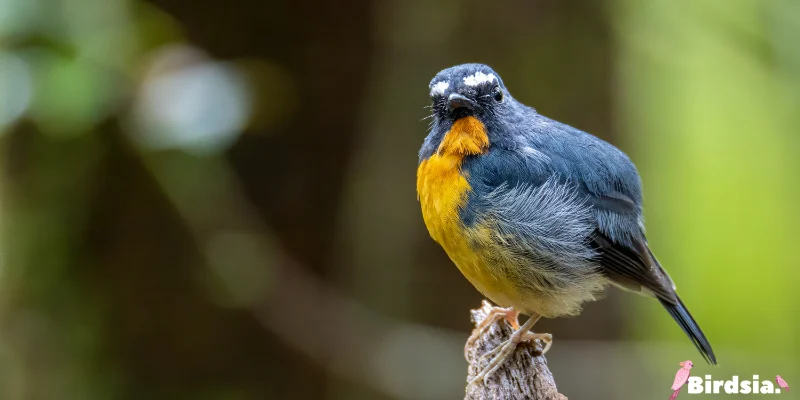
In Florida, there are lots of different kinds of black birds, from ones that live near water to those that sing and even vultures. Because Florida is warm and close to the Gulf of Mexico and places like the Caribbean, Central America, and Northern South America, it’s a great place for birds that migrate or want to escape the cold.
But did you know how many different kinds of blackbirds there are in Florida? Out of the 25 New World Blackbirds found in North America, including Blackbirds, Orioles, Meadowlarks, Cowbirds, Grackles, and Bobolinks, 19 have been spotted in Florida. After doing some digging, we’ve put together a list of the various types of black birds you might find in Florida.
This article will focus on birds that are mostly black. We’ll give you tips on how to tell them apart, whether you’re a pro birdwatcher or just starting. Learning about these black birds can make birdwatching in Florida even more fun!
Here is a list of the 21 fascinating black birds found in Florida:
1. Double-Crested Cormorant:
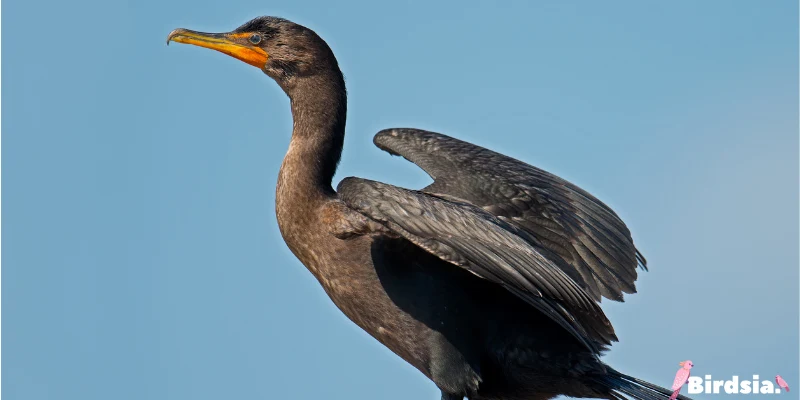
he Double-crested Cormorant is a stunning waterbird commonly found across North America. With its sleek body covered in dark feathers, bright orange skin around its beak, and piercing blue eyes, it’s hard to miss. During the breeding season, they grow two tufts of black feathers on each side of their head, earning them their name “double-crested.”
These cormorants are pretty adaptable, living in all sorts of watery places like lakes, rivers, and marshes, as well as coastal areas and estuaries. They’re excellent swimmers and divers, using their webbed feet to hunt fish and other water critters. You might even see them spreading their wings to dry off after a swim, which makes them look pretty unique when they’re resting.
They mostly eat fish but will munch on insects, crustaceans, or frogs now and then. Sometimes, they can get a bit aggressive with other birds, stealing food from ospreys and bald eagles. In Florida, they stick around all year in most places, but you might only see them in the winter up in the panhandle.
Measurement of Double-Crested Cormorant (Nannopterum auritum):
- Length: 11.0–12.2 inches
- Weight: 3.9-5.6 ounces
- Wingspan: 16.5-20.1 inches
2. Anhinga

Anhingas, also known as “snake birds” or “water turkeys,” live in shallow, sheltered freshwater areas filled with trees and tall grasses, like mangroves, wetlands, and lagoons. You can spot these unique birds all year-round in Florida.
With their black bodies highlighted by white wings and long necks, Anhingas are often seen gliding gracefully through the water, with only their necks sticking out. Their distinctive appearance, along with their turkey-like tail feathers, gives rise to their interesting nicknames.
Anhingas mainly eat fish, which they catch by stealthily swimming underwater and spearing their prey with their sharp bills. Unlike ducks, Anhingas don’t have waterproof feathers. So, after swimming, they perch on the shore, spreading out both wings to dry them off completely.
Measurement of Anhinga (Anhinga anhinga):
- Length: 35-37 inches
- Weight: 2.6-3.7 pounds
- Wingspan: 45-48 inches
3. Black Skimmer

Black Skimmers are commonly found along the coastlines of Florida, residing in places like beaches, sandbars, estuaries, and lagoons all year round. These birds have some unique features, including long wings, black upper bodies, and white underparts. But what really stands out is their long, razor-sharp bills, with the lower one longer than the upper.
During the breeding season, Black Skimmers nest in groups and lay about three to four eggs in shallow scrapes on the beach. They’re pretty adaptable to human activity, often seen near piers and marinas where they can find plenty of food.
When they’re hunting for food, Black Skimmers have a cool technique. They fly low over the water with their lower bills submerged, using special nerves to feel for fish and other prey. Once they detect something, they snap their bills shut quickly. This unique way of feeding makes it fascinating to watch for bird lovers and nature enthusiasts.
Besides their interesting feeding habits, Black Skimmers have distinct calls, including barks, chatter, and screams. These sounds help them communicate and interact with each other in their colonies.
Measurement of the Black Skimmer (Rynchops niger):
- Length: 16-20 inches
- Weight: 7–15 ounces
- Wingspan: 44–50 inches
4. American Coot

The American Coot is often likened to a chicken, with its round body covered in black feathers. Although similar to the Gallinule, it has distinct white beaks and dark red eyes. Unlike ducks, they have long, lobed toes instead of webbed feet, allowing them to navigate through water vegetation efficiently.
Found in freshwater wetlands, they prefer shallow waters with vegetation during the breeding season and often mingle with ducks in the winter. While most of Florida hosts them only in non-breeding months, they reside year-round in the southern tip of the state.
Measurement of American Coot (Fulica americana)
- Length: 13–16 inches
- Weight: 1.4-2.1 pounds
- Wingspan: 23–25 inches
5. Magnificent Frigatebird
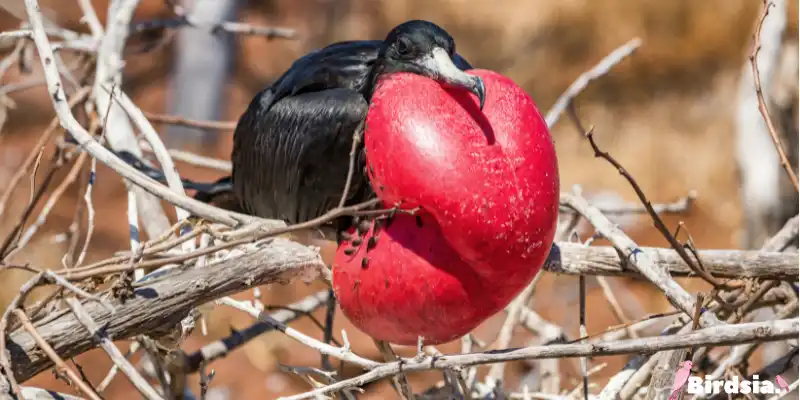
The Magnificent Frigatebird, known for its impressive wingspan of up to 7.5 feet, is a common sight along Florida’s coastal regions. Found year-round in coastal areas, they breed in larger numbers in the Keys and southern regions. These seabirds spend much of their time soaring gracefully overhead and have long wings and forked tails.
Using their hooked bills, Magnificent Frigatebirds snatch fish and other marine prey from the ocean’s surface. They also engage in opportunistic feeding, stealing food from other seabirds midair. During breeding season, males sport an all-black plumage with a red throat sac, while females have a black body with a white patch on their chest. Despite their impressive presence, they face threats like habitat loss and pollution, leading to population declines in some areas.
Measurement of Magnificent Frigatebirds (Fregata magnificens):
- Length: 35-45 inches
- Weight: 2.6-3.9 pounds
- Wingspan: 7.5–90 inches
6. Common Gallinule
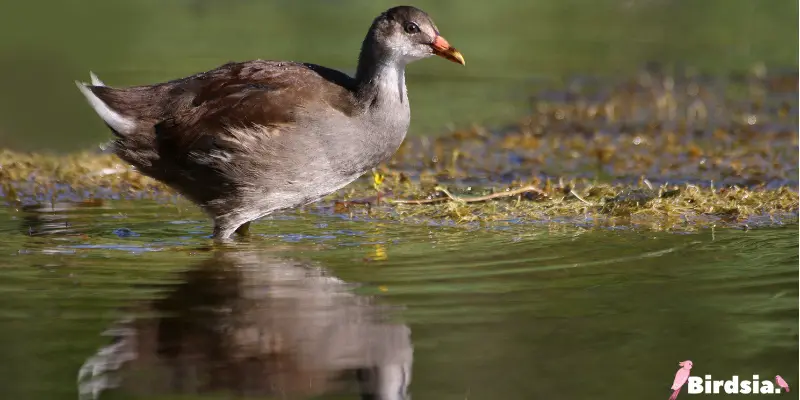
The Common Gallinule, a sturdy waterbird found from the United States to South America, prefers habitats like freshwater marshes, lakes, and ponds with open water and floating vegetation. In Florida, they are year-round residents, commonly seen in the state’s waterways.
Feeding on flower seeds, vegetation, and insects from the water’s surface, Common Gallinules have a diverse diet. They use their long toes to flip floating leaves and plants to find snails, showcasing their resourcefulness.
Identified by their dark body, red beak and forehead, and greenish-yellow legs and feet, Common Gallinules have distinct physical features. Their long, lobed toes help them walk on aquatic vegetation like lily pads and avoid sinking into soft mud, adapting well to various wetland environments.
Measurement of Common Gallinules (Gallinula galeata):
- Length: 10–15 inches
- Weight: 6.3–12.3 ounces
- Wingspan: 21–24 inches
7. Fish Crow
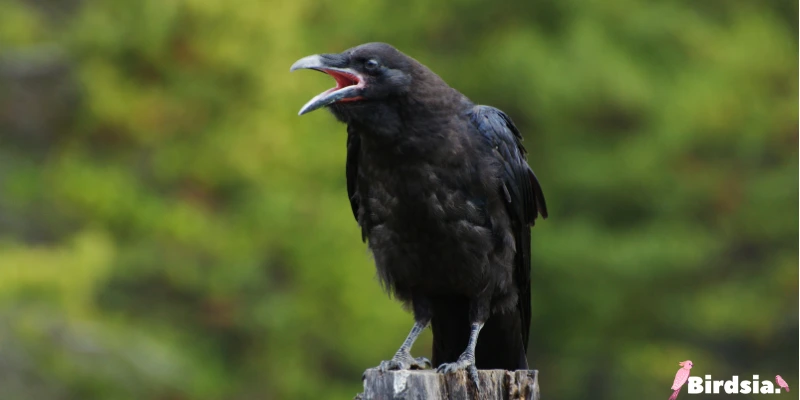
Fish crows, similar to American crows but with subtle differences, are slightly smaller with a slender bill and a distinct, hoarser call often delivered in doubled-up sequences. These medium-sized birds primarily inhabit coastal marshes, swamps, and wetlands along the Atlantic and Gulf coasts, extending inland to riversides and stream banks. In Florida, they are a common sight year-round, thriving in diverse aquatic habitats.
Their diet includes fish, shellfish, insects, small mammals, bird eggs, and carrion, reflecting their coastal habitat. Fish crows are skilled at cracking open hard-shelled prey like crabs and clams with their robust bills, preferring aquatic species and seafood.
Highly social, fish crows gather in large flocks, similar to American crows. They are opportunistic feeders, often stealing food from other birds or raiding nests for eggs and young, showcasing their resourceful and adaptable nature in finding food.
Measurement of Fish Crow (Corvus ossifragus):
- Length: 14-16 inches
- Weight: 9–13 ounces
- Wingspan: 29-33 inches
8. Black Vulture
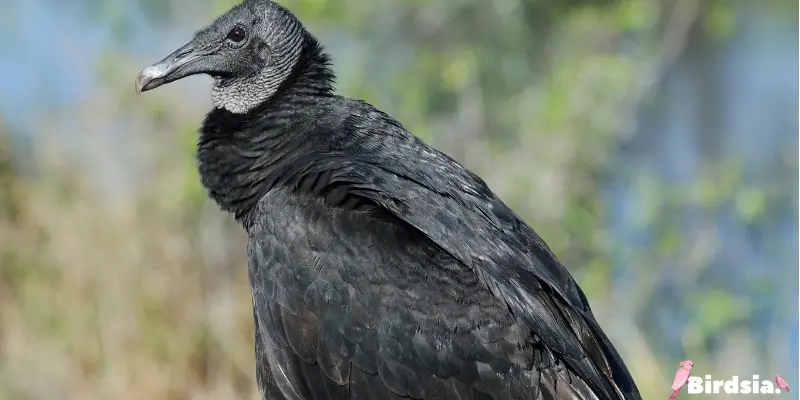
Black vultures, darker and sturdier than turkey vultures, have gray-skinned faces and hooked beaks, ideal for their scavenging lifestyle. Their bare heads make cleaning up after feeding easier.
Unlike turkey vultures, they rely less on smell, often following them to find food. Social creatures gather in family groups, with parents feeding fledglings even after they leave the nest. They share food among relatives, strengthening family bonds.
These adaptable scavengers are year-round residents of Florida and are commonly seen in habitats abundant with carrion. With their unique appearance and communal behaviors, black vultures play a crucial role in cleaning up the ecosystem.
Measurement of the Black Vulture (Coragyps atratus):
- Length: 24-27 inches
- Weight: 3-5 pounds
- Wingspan: 54–60 inches
9. Bobolink
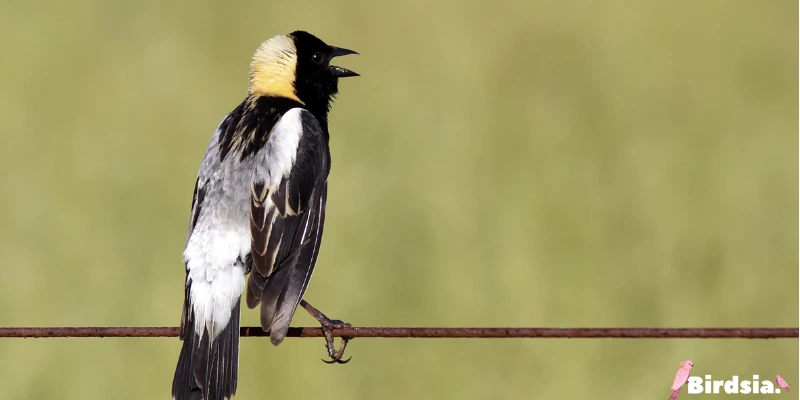
Bobolinks, small migratory birds, briefly visit Florida during spring and fall migrations. During the breeding season, males flaunt striking black plumage with white accents and a splash of yellow at the neck, contrasting with females’ mottled brown and yellow hues. After breeding, males lose their black feathers, resembling females.
Primarily seed-eaters, bobolinks search grasslands for food, enjoying seeds and insects. Male bobolinks announce their presence with vibrant, bubbly songs and captivating aerial displays, ascending skyward while singing. These enchanting behaviors add vibrancy to Florida’s landscapes during migration seasons.
Measurement of Bobolink (Dolichonyx oryzivorus):
- Length: 6.3–7.9 inches
- Weight: 1.0-1.5 ounces
- Wingspan: 9.8–11.8 inches
10. Smooth-Billed Ani

The Smooth-billed Ani’s striking black plumage and distinctive elongated tail, coupled with its robust beak reminiscent of a parrot’s, make it a standout bird. Omnivorous by nature, it enjoys a varied diet of insects, fruits, and small lizards.
Often seen in communal groups, these birds exhibit cooperative nesting behaviors, constructing communal nests in thorny trees where multiple females contribute to a large clutch of eggs, sometimes up to 36. Both males and females actively incubate the eggs and care for the young, showcasing remarkable communal care.
While primarily found in Central and South America and the Caribbean, Smooth-billed Anis have also been spotted in Florida. However, their numbers have declined since the 1970s due to landscape changes and pesticide use.
As a result, sightings have become rare, especially in central and southern regions where they prefer wet, shrubby habitats. Despite their dwindling population, the Smooth-billed ani remains a fascinating bird, symbolizing the complex ecological dynamics of Florida’s ecosystems.
Measurement of Smooth-Billed Ani (Crotophaga ani):
- Length: 12–14 inches
- Weight: 3.5–5.315–18 ounces
- Wingspan: 15–18 inches
11. Red-Winged BlackBird
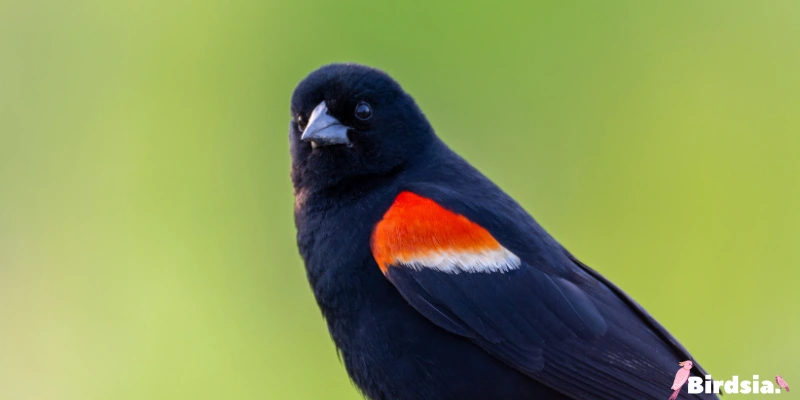
Red-winged Blackbirds are super common all over North America. You can spot them easily by their sleek black feathers and bright red and yellow patches on their shoulders. The males especially like to show off these colors, but sometimes they hide them.
These birds love hanging out in wetlands, especially near ponds and marshes with lots of cattails and reeds. They build their nests in the tall plants close to the ground. During the summer, you’ll often see males sitting on top of cattails, singing their unique “conk-la-lee” song to attract mates.
Red-winged Blackbirds are everywhere in Florida, all year round. They add to the state’s diverse bird population and make it even more beautiful.
Measurement of the Red-Winged Black Bird (Agelaius phoeniceus):
- Length: 7-9 inches
- Weight: 1.1-2.7 ounces
- Wingspan: 12–15 inches
12. Eastern King Bird
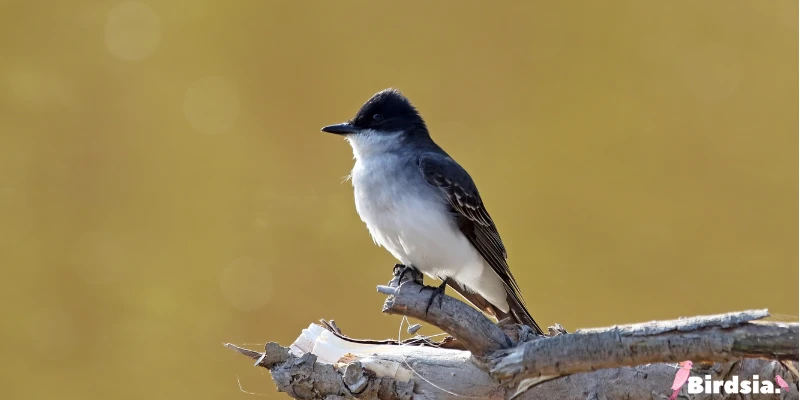
The Eastern Kingbird is a medium-sized bird known for its striking black-and-white feathers. They have a black head, back, and tail, with a white throat, chest, and belly. What really makes them stand out are their white-tipped tail feathers, which you can see from behind. They also have a colorful crown on their heads, but it’s often hidden.
These birds are fearless defenders of their territory, even taking on bigger birds like hawks. You’ll often see them perched up high, keeping an eye out for any threats.
Eastern Kingbirds mainly eat insects like flies, bees, and grasshoppers, which they catch mid-flight with impressive agility. They also consume fruits, berries, and seeds. They love open areas like fields and meadows, and you can spot them in Florida during the spring and summer, adding their beautiful songs and colors to the state’s birdlife.
Measurement of the Eastern King Bird (Tyrannus tyrannus):
- Length: 7-9 inches
- Weight: 1.2-1.6 ounces
- Wingspan: 13–15 inches
13. Brown-Headed Cowbird
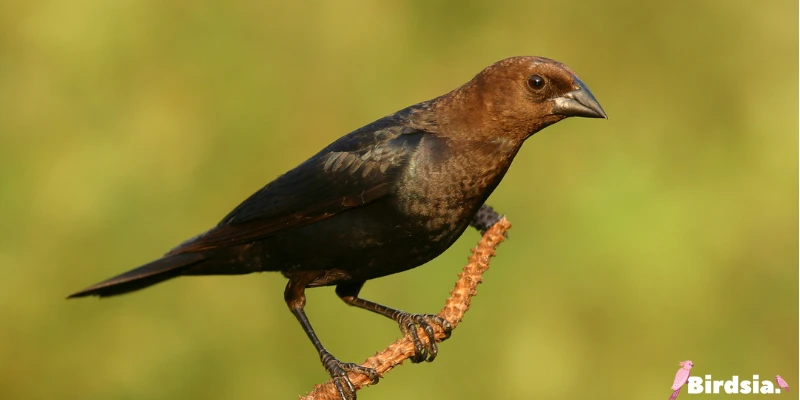
Brown-headed cowbirds are often grouped with blackbirds due to their dark plumage and tendency to flock together, sometimes mingling with actual blackbirds. Males have shiny black bodies with dark brown heads, while females are lighter brown overall.
These adaptable birds thrive in woodland edges, thickets, and fields and have adapted well to human development, even flourishing in residential areas. While they can be found year-round in northern Florida, they mainly visit southern regions during non-breeding months.
Unfortunately, brown-headed cowbirds have earned the nickname “nest parasites” because of their reproduction strategy. They sneakily lay their eggs in other bird species’ nests, often at the expense of the host’s own eggs or chicks. This behavior highlights the challenges faced by host species in defending against these intruders.
Measurement of Brown-Headed Cowbird (Molothrus ater):
- Length: 6.3–8.7 inches
- Weight: 1.1-1.8 ounces
- Wingspan: 11–15 inches
14. Rusty Blackbird
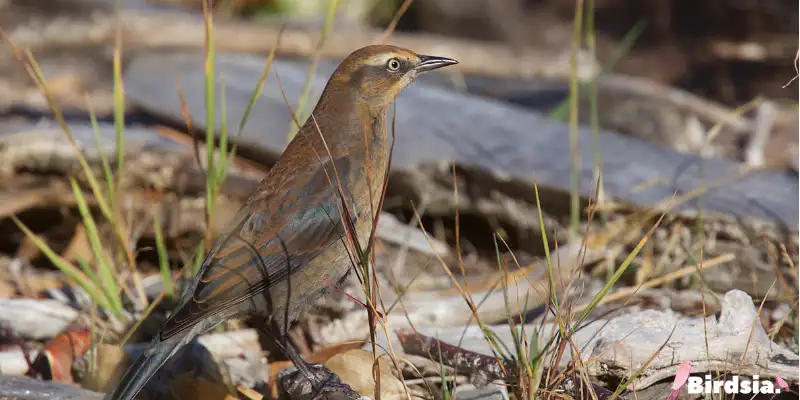
Rusty blackbirds are a common sight during the winter across much of the eastern United States, including northern and central Florida. However, they migrate northward to breed in Canada and Alaska during the warmer months of spring.
Sadly, their population has declined significantly, with over 85% disappearing in the last forty years. While the exact cause is unknown, habitat loss, especially in their wintering areas, is believed to be a major factor.
Male rusty blackbirds sport glossy black plumage during breeding season, but in Florida, they develop rusty brown spots on their head and back.
They prefer wet habitats like bogs, marshes, and wet woodlands, where they feed on insects in the summer and switch to acorns, berries, and pine seeds in the winter. Despite their adaptability, urgent conservation efforts are needed to protect their habitats and address the threats they face.
Measurement of the Rusty Blackbird (Euphagus carolinus):
- Length: 7.5-8.7 inches
- Weight: 1.5–2.1 ounces
- Wingspan: 13–15 inches
15. Shiny Cowbird
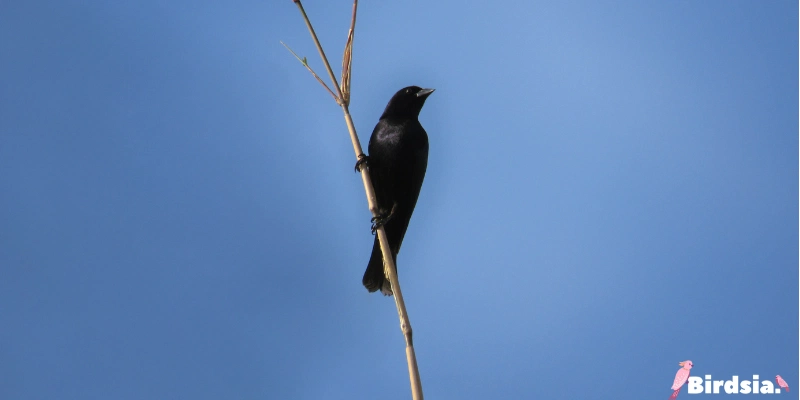
The shiny cowbird, originally from South America, has successfully established itself in the Caribbean and Florida. Males have glossy purple-black feathers, while females are dark brown with a lighter throat and belly.
They primarily eat insects but also consume fruits, grains, seeds, and small vertebrates. They’re known for their reproductive strategy of laying eggs in other birds’ nests, which can make it challenging to identify their breeding patterns in Florida. They occupy various habitats, including agricultural fields, suburbs, and wetlands.
However, their presence as an invasive species raises concerns for native birds. Therefore, monitoring and management efforts are essential to preserving Florida’s avian ecosystems.
Measurement of the Shiny Cowbird (Molothrus bonariensis):
- Length: 6.7–7.9 inches
- Weight: 1.3-1.6 ounces
- Wingspan: 10–12 inches
16. Common Grackle
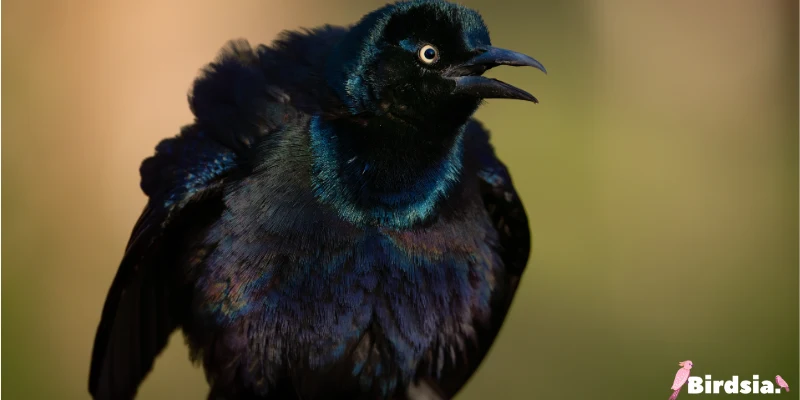
Grackles, often called “bully birds,” have a surprising beauty with iridescent feathers that can shimmer with hues of blue, green, brown, and purple under the right light. They’re often mistaken for Brewer’s blackbirds, but grackles have a heavier beak and a bronze tint to their bodies.
They sometimes gather in huge flocks, numbering in the millions, and may roost with other blackbird species. Their diet is varied, including insects, seeds, grains, fruits, and scavenging through trash. Found in suburban areas, forest edges, parks, meadows, and swamps, grackles are year-round residents across most of Florida.
Measurement of Common Grackle (Quiscalus quiscula):
- Length: 11–13 inches
- Weight: 2.8-5.0 ounces
- Wingspan: 14–18 inches
17. Brewer’s Blackbird
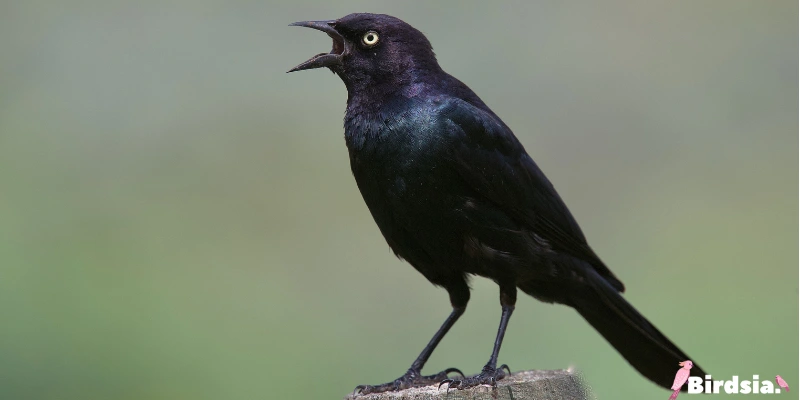
Male Brewer’s blackbirds are easy to spot with their shiny black feathers that shine purple or green in the sunlight, and they have bright yellow eyes. They’re a bit bigger than the females and have longer tails. With their sharp beaks, they look for bugs, seeds, and fruit.
These birds like to hang out with others and often gather in large groups when they’re not breeding. During mating season, males claim areas and try to attract multiple females. They make nests out of grass and mud in trees, bushes, or even on the ground.
Brewer’s blackbirds can live in different places, like cities, farms, and grassy areas. In Florida, they’re mostly in the northern part of the state, especially in the panhandle, during the fall and winter. You might see them pecking at seeds on the ground or sitting on power lines—they’re pretty common in lots of places.
Measurement of Brewer’s Blackbird (Euphagus cyanocephalus):
- Length: 8.3–10.2 inches
- Weight: 2.0–3.0 ounces
- Wingspan: 14–18 inches
18. European Starling
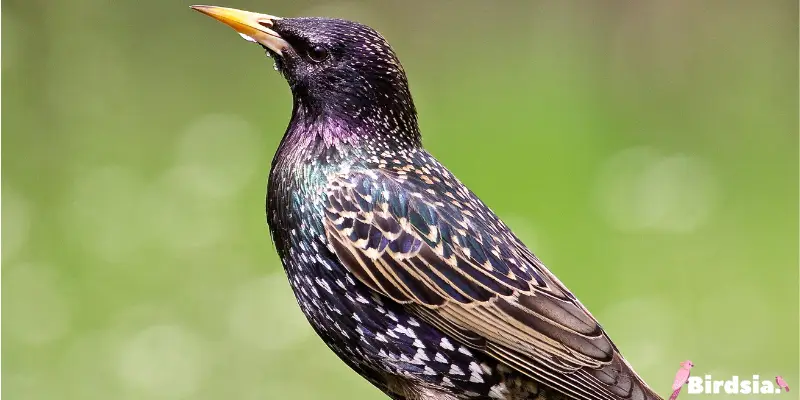
European Starlings are medium-sized birds known for their stout bodies, short tails, and long, pointed yellow bills. In the breeding season, their shiny black feathers have white spots, but they look more plain the rest of the year.
These birds came to the United States in the late 1800s and are now found all over, including Florida. They’re very adaptable and can live in cities, farms, and forests.
European Starlings eat a bit of everything—bugs, fruit, and seeds. They’re good at finding food on the ground or up in trees, and they often hang out in big groups. In the winter, you might see lots of them roosting together, sometimes with other kinds of blackbirds.
Measurement of European Starling (Sturnus vulgaris):
- Length: 7.5–9.1 inches
- Weight: 2.0-3.4 ounces
- Wingspan: 12-17
19. Boat-tailed Grackle
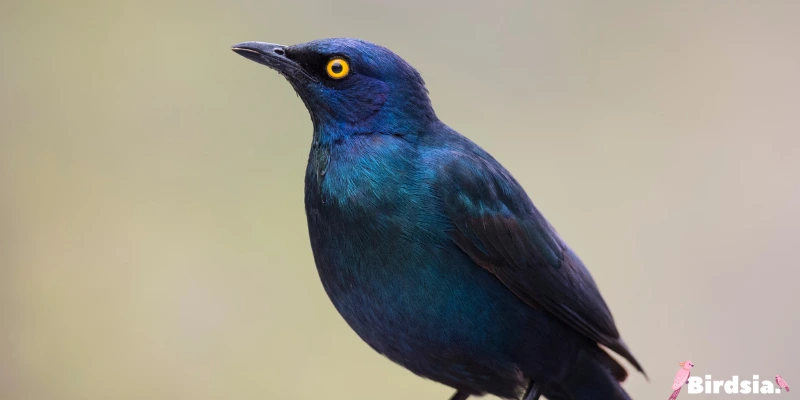
Boat-tailed Grackles are striking birds often seen along the coasts of the Atlantic and Gulf. The males have shiny black feathers with hints of purple and blue, yellow eyes, and a distinct boat-shaped tail they flaunt during courtship. Females, on the other hand, are golden brown with dark wings.
These grackles usually nest in saltwater marshes but are flexible in their search for food, scavenging on beaches, in coastal towns, and even in urban areas. They’re social birds, gathering in large groups and communicating through various calls.
In Florida, you can spot Boat-tailed Grackles year-round throughout most of the state. Along the panhandle coastlines, they’re especially abundant, adding to the coastal atmosphere with their colorful appearance and lively sounds.
Measurement of Boat-Tailed Grackle (Quiscalus Major):
- Length: 14-18 inches
- Weight: 3.6-7.7 ounces
- Wingspan: 18-22 inches
20. American Crow
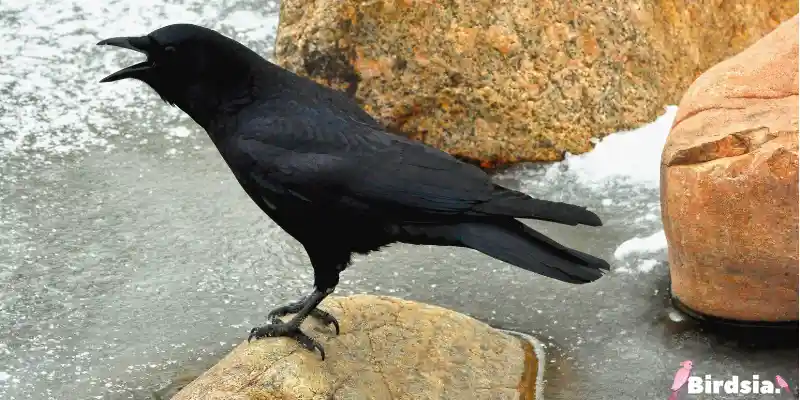
The American Crow is a common sight throughout Florida, known for its sleek all-black plumage. These medium-sized birds are year-round residents and have a distinctive appearance.
As omnivores, they have a varied diet, feeding on everything from carrion and insects to fruits and seeds. They’re also skilled nest raiders, often stealing eggs and nestlings from other birds.
American crows are highly adaptable and can be found in diverse habitats, including urban areas, forests, and grasslands. They’re intelligent birds known for using tools and are often seen in large groups, especially during winter, when their loud calls fill the air.
Measurement of the American Crow (Corvus brachyrhynchos):
- Length: 16–21 inches
- Weight: 11–21 ounces
- Wingspan: 33-39 inches
21. Eastern Meadowlark
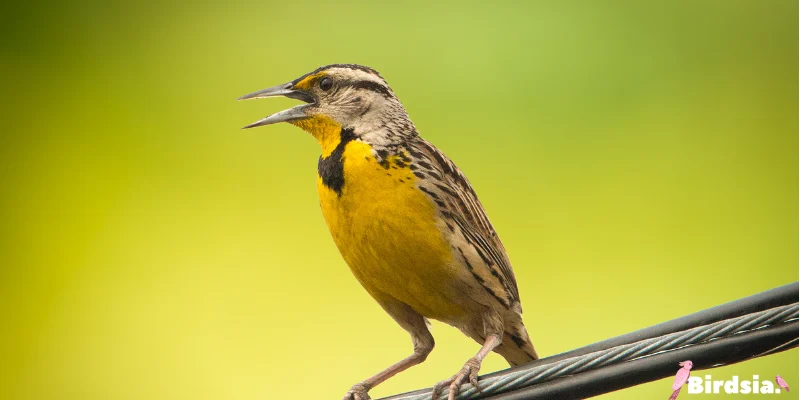
Despite their near-threatened status, Eastern Meadowlarks are a year-round sight in Florida, appearing on 3% of winter checklists and 5% of summer checklists. These medium-sized birds are known for their striking appearance, with a bright yellow underside, a pale brown back, and distinctive black markings.
Found throughout the eastern United States, they breed primarily in the Northeast and Canada before migrating south. Their melodious songs herald the arrival of spring, making them a symbol of the changing seasons.
Despite their cultural significance, Eastern Meadowlarks face threats to their survival, making conservation efforts crucial to protecting their populations in Florida and beyond.
Measurement of the Eastern Meadowlark (Sturnella magna):
- Length: 7.5-9.5 inches
- Weight: 3.0-5.0 ounces
- Wingspan: 13–16 inches
Final Thought:
In conclusion, Florida’s diverse ecosystems provide habitat to a wide array of captivating blackbird species, each contributing to the state’s rich avian tapestry. From the elegant waterfowl like the Double-Crested Cormorant and Anhinga to the charismatic songbirds like the Red-Winged Blackbird and Eastern Meadowlark, these birds offer both visual splendor and ecological importance.
Through this comprehensive guide, we’ve explored 21 striking black bird species found in Florida, delving into their unique characteristics, behaviors, and habitats. With stunning photos accompanying each entry, readers have been provided with a closer look at these fascinating avian inhabitants.
Whether you’re a seasoned birdwatcher or just beginning to appreciate the wonders of nature, exploring the diverse black bird species of Florida offers an enriching experience. By understanding and appreciating these birds, we can contribute to their conservation and ensure their continued presence in Florida’s ecosystems for generations to come.
Which is a common black bird?
The common blackbird, scientifically known as Turdus merula, belongs to the true thrush family. It’s sometimes referred to as the Eurasian blackbird, especially in North America, to differentiate it from unrelated New World blackbirds. In areas where confusion isn’t likely, it’s simply called the blackbird.
What is the black bird that looks like a crow in Florida?
In the southern and southwestern United States, people sometimes call the grackle a “blackbird” or mistakenly think it’s a “crow” because of its shiny black feathers. But grackles belong to their own group, separate from other “blackbirds” like the red-winged and Brewer’s blackbirds, even though they’re all part of the same bird family.
Are black crows common in Florida?
Crows are prevalent in Florida and can be spotted in diverse habitats across the state.
What is a long-necked bird in Florida?
The Anhinga, often called the snake bird or water turkey, lives in Florida all year round. You can also find it along the coast, from South Carolina to Texas and Mexico, and even as far south as Argentina.
Please Write Your Comments